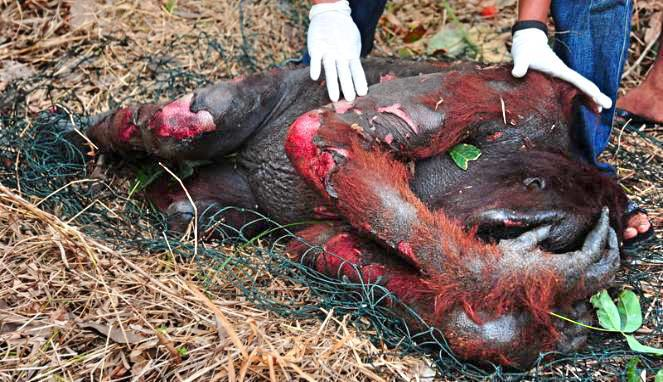 Reasons to Go Vegan #8: Palm Oil
Reasons to Go Vegan #8: Palm Oil
 Palm Oil Plantations: The Exctinction of Orangutans, Siberian Tigers and Siberian Elephants in Indonesia
Palm Oil Plantations: The Exctinction of Orangutans, Siberian Tigers and Siberian Elephants in Indonesia
 Humanity's true moral test, its fundamental test… consists of its attitude towards those who are at its mercy: animals. And in this respect humankind has suffered a fundamental debacle, a debacle so fundamental that all others stem from it.
Humanity's true moral test, its fundamental test… consists of its attitude towards those who are at its mercy: animals. And in this respect humankind has suffered a fundamental debacle, a debacle so fundamental that all others stem from it.
—Milan Kundera, "The Unbearable Lightness of Being."
 The biggest threat to orangutan populations is undoubtedly the increasing expansion of palm oil plantations. Native to West Africa, the oil palm tree produces large quantities of red fruits, which, when crushed, produce an oil that has been traditionally used as a cooking oil, in soap and as a lubricant for steam engines. Extremely versatile, as its use has grown, so has demand, and 48 million tonnes are now produced each year for the world export market (Oil World Trade Journal, 2008), with Indonesia and Malaysia accounting for 90% of this production (FOE, 2006). Today, palm oil is found in a vast array of food and consumer products, from ice cream to shampoo, peanut butter to candles. WWF estimates that 50% of all packaged supermarket products contain palm oil, and demand is now growing for its use as a "green" biofuel.
The biggest threat to orangutan populations is undoubtedly the increasing expansion of palm oil plantations. Native to West Africa, the oil palm tree produces large quantities of red fruits, which, when crushed, produce an oil that has been traditionally used as a cooking oil, in soap and as a lubricant for steam engines. Extremely versatile, as its use has grown, so has demand, and 48 million tonnes are now produced each year for the world export market (Oil World Trade Journal, 2008), with Indonesia and Malaysia accounting for 90% of this production (FOE, 2006). Today, palm oil is found in a vast array of food and consumer products, from ice cream to shampoo, peanut butter to candles. WWF estimates that 50% of all packaged supermarket products contain palm oil, and demand is now growing for its use as a "green" biofuel.
Source: http://bit.ly/t21wsO
August 28, 2012
A male orangutan coveres his face after being anesthetized and falling from a tree in the Village Desa Parit Wak Dongkak, Wajok Lower district, Pontianak, Kalbar, on Monday (08/27/2012)
Rescue team members perform a number of medical aid procedures on male orangutans who were seriously injured. Males orangutans suffered burns following the citizens' efforts to evict them by burning the trees. FOTO ANTARA / Jessica Helena Wuysang" Source: http://bit.ly/PX0HWf
Please click here to read more about the "Threats to Orangutans":
"Horror In Indonesia"
Apparently villagers in Wak, Pontianak,West Kalimantan, Indonesia, burned trees to stop orangutans raiding their land, this orangutan fell down and was badly injured. Medical team doing best to help. The article mentions that the orangutans are listed as endangered. If this makes you as mad as it makes me then you can do 2 things today to take action:
1 - BOYCOTT: Never buy any product that contains Palm Oil, Indonesia is the world's biggest supplier of Palm Oil
2 - Call the Indonesian Consulate and tell then to put an immediate stop to this criminal activity at (213) 383 - 5126 Thank you!!"
Articles
-
 Palm Oil's Forgotten Victims: Sumatran Elephants Suffer in Rush for Liquid Ivory, LinkTV, 8/2103
Palm Oil's Forgotten Victims: Sumatran Elephants Suffer in Rush for Liquid Ivory, LinkTV, 8/2103
Western consumers are inadvertently driving the Sumatran elephant to extinction by eating, washing, and wearing - in cosmetics - the derivatives of a fruit that is destroying the animal's last remaining forest habitat. Jim Wickens reports. More…
-
Worrying news for critically endangered Siberian tigers —Earth Times, 3/2012
 The Critically Endangered Siberian tiger has an effective population of just 14 animals - that's the worrying conclusion of a recent study into these stunning cats.
The Critically Endangered Siberian tiger has an effective population of just 14 animals - that's the worrying conclusion of a recent study into these stunning cats.
Troubling times for Siberian tigers
The Siberian tiger, also known as the Amur tiger, is the world's largest cat. Previously it ranged far across northern China, Korea and south eastern Russia. In the early 20th Century the Siberian tiger was driven close to extinction through poaching and habitat loss and was wiped out from 90% of its once large range. By the 1940s, only 20 to 30 wild Siberian tigers remained. Over the past 60 years, the population has increased to 500. However, scientists have recently discovered that the effective population of Siberian tigers is just 14.
Effective population is a measure of the genetic diversity of a species. A low effective population means that there is low genetic diversity within the Siberian tiger population as a whole.
A more genetically diverse population of Siberian tigers has much better chance of survival. A genetically diverse population is more likely to have resistance to a variety of diseases and is less likely to succumb to rare genetic disorders. Low genetic diversity means that any rare genetic disorders, mutations or susceptibility to disease is likely to be passed on to the next generation. More… -
Demand for palm oil, used in packaged food products, leaves orangutans at risk —NBC News, 10/2012.
One of the Sumatran orangutan's richest habitats, an area of swampland containing the highest density of the red apes on the planet, is being illegally slashed and burned by palm oil companies to make way for palm oil plantations.
"If we can't stop them here, then there really is no hope," said Ian Singleton as we stood on the edge of what had once been pristine forest, home to hundreds of orangutans, but now reduced to a charred wilderness as far as the eye could see. As he spoke we could hear the distant sound of a chain saw. More… -
Indonesia's tiger habitat pulped for paper, investigation shows, The Guardian, 2/2012
The habitat of the endangered Sumatran tiger is being rapidly destroyed in order to make tissues and paper packaging for consumer products in the west, new research from Greenpeace shows.
A year-long investigation by the campaigning group has uncovered clear evidence, independently verified, that appears to show that ramin trees from the Indonesian rainforest have been chopped down and sent to factories to be pulped and turned into paper. The name ramin refers to a collection of endangered trees growing in peat swamps in Indonesia where the small number of remaining Sumatran tigers hunt. More… -
Say No To Palm Oil
30 NAMES PALM OIL CAN BE LABELLED UNDER
Foods, Body Products, Cosmetics & Cleaning Agents:- Vegetable Oil
- Vegetable Fat
- Sodium Laureth Sulfate (in almost everything that foams) ^
- Sodium Lauryl Sulfate ^
- Sodium Dodecyl Sulphate (SDS or NaDS) ^
- Palm Kernel#
- Palm Oil Kernel #
- Palm Fruit Oil #
- Palmate #
- Palmitate #
- Palmolein #
- Glyceryl Stearate #
- Stearic Acid #
- Elaeis Guineensis #
- Palmitic Acid #
- Palm Stearine #
- Palmitoyl oxostearamide #
- Palmitoyl tetrapeptide-3 #
- Steareth -2 *
- Steareth -20 *
- Sodium Kernelate #
- Sodium Palm Kernelate #
- Sodium Lauryl Lactylate/Sulphate *
- Sodium Lauryl Sulfoacetate ^
- Hyrated Palm Glycerides #
- Sodium Isostearoyl Lactylaye ^
- Cetyl Palmitate #
- Octyl Palmitate #
- Cetyl Alcohol ^
- Palmityl Alchohol #
# These ingredients are definitely palm oil or derived from palm oil.
* These ingredients are often derived from palm oil, but could be derived from other vegetable oils.
^ These ingredients are either derived from palm oil or coconut oil.
Resources
-
Roundtable On Sustainable Palm Oil
Download the latest version of their shopping guide.
-
Orangutan Foundation International
The destruction and degradation of the tropical rain forest, particularly lowland forest, in Borneo and Sumatra is the main reason orangutans are threatened with extinction. This has been caused primarily by human activity (intense legal logging, illegal logging, conversion of forest to palm oil plantations and timber estates, mining, clearing forest for settlements, and road construction) and also by large-scale fires facilitated by the El Nino weather phenomena. Additionally, the illegal animal trade has been a factor in the decline of wild orangutan populations. Finally, orangutans are occasionally hunted and eaten by some of the indigenous peoples of Borneo as well as migrant loggers and plantation workers who do not have dietary prohibitions against eating primate bushmeat. More…
-
Rainforest Action Network - Palm Oil
Truth and Consequences: Palm Oil Plantations Push Unique Orangutan Population to Brink of Extinction A manmade inferno inside the globally renowned Tripa rainforest in Aceh, Indonesia is pushing this forest?s unique population of Sumatran orangutans to the brink of extinction. Destruction inside palm oil plantation leases is driving the end of this great lowland forest, despite years of efforts by local communities to defend their forests and livelihood. More…
Still not convinced? Listen to these.
For further in depth data
See our Resources pages including books, films, local restaurants and more.
Top ↑

 Your Health
Your Health Physiology
Physiology Abuse/Cruelty
Abuse/Cruelty Dairy
Dairy The Planet
The Planet Pollution
Pollution Veal
Veal Global Warming
Global Warming Animal Acts
Animal Acts The Ocean
The Ocean Slaughter
Slaughter Wool
Wool Lab Animals
Lab Animals





